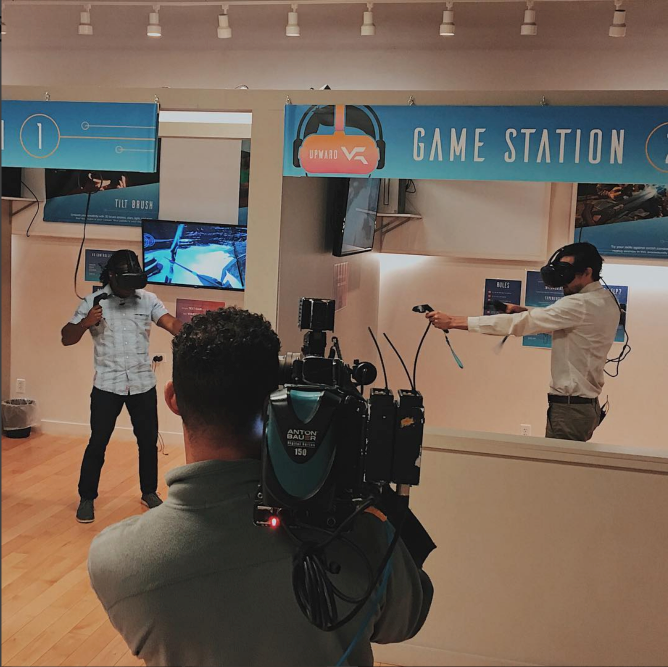Will Stackable of Springboard VR on the State of Location-based Entertainment

Following our last week’s interview with Ryan from VAL and in honour of the ongoing global Skyfront arcade tournament, we delve even deeper into the workings of location-based entertainment.
This week I had the pleasure of picking the brain of Will Stackable, the co-founder of Springboard VR. If you’re new to location-based entertainment, Springboard VR is THE platform for managing stations, launching games and distributing content for location-based VR.
Brace yourself for about a ten minute read! I couldn’t even have hoped for the amazingly thorough and insightful answers Will gave me.
–––
Hope you’ve had a great week so far, Will! Glad to have you with us! Starting off with the basics – what do you do at Springboard?
I’m one of the three co-founders and head the Content team.
Where did the idea for Springboard come from and where is the platform headed?
We opened one of the first VR arcades right after the HTC Vive came out. We saw it as a way to get a foot in the door and start a cash-generating business in the VR space while the market developed. We initially built Springboard VR as primarily a management platform for arcades. We quickly realized that every VR arcade was going to need something like it – demand was high and we launched with 40 locations.
The last six months or so, we’ve began to focus more heavily on the content side of things. One of the biggest problems facing VR arcades is finding and licensing great content at a price that makes sense for their business model. To serve that pain point, we now have a commercial licensing marketplace with over 250 titles. In just over a year, we’ve grown to 450+ locations on the platform, adding 40 to 50 a month, spread out over 40 countries. It’s been really exciting to see how rapidly the location-based entertainment VR space has exploded in the last 12 months!
Big picture, we’re hoping to help address one of the recurring problems that brand new industries face. You need great content (and hardware) to attract a bunch of users, but you also need a sizeable market to justify spending money on making great content and hardware in the first place.
The consumer market in VR is still very small and we see the out-of-home space as an area where content creators can make a steady monthly income to help bridge the gap between where we are now and the future mass consumer market we all know is coming.

What has working with arcades across the globe taught you about VR and the people that are passionate about it?
We’re all pioneers – it’s a brand new medium that is still in its early stages. The industry is small enough that we’re all trying to help each other. Everyone is doing this because they love it and believe in the potential of VR. It’s so much fun to be part of a group of passionate innovators who are going to go down in history as the makers of an industry.
Are you a VR gamer/athlete yourself?
Yes! Currently playing Beat Saber, To the Top and Skyfront (need to jump back in, it’s been a month since I’ve played!). Part of the fun of my job is getting to play around in VR every day. 🙂
Where do you see the VR arcade market moving in the next twelve months?
I’ll break it down into a couple of segments.
I think we’ll see a maturation of the “indie” VR arcade scene. Some of the players are already franchising and launching second, third or fourth locations. The business models have started to gel and operators are learning how to run a solid LBE business.
Arcades are going to continue growing multiple income streams. VR Arcades are physical locations with high-end VR setups that can be used in multiple ways:
– Birthday parties and other events;
– After school programs and field trips;
– Firemen doing safety training in VR;
– Field trips for nursing homes to let seniors travel to Stonehenge;
– Corporate day trips to expose execs to new technology;
– Narrative VR short film screenings;
– An eSports tournament location with mixed reality twitch streaming and multiplayer team play;
– Multi-configuration VR center (free roam one day, VR stations the next).
We’ll see more VR arcades experiment with free roam and larger room scale setups and content. Some will build flexible configurations to do room scale booths one day and then move things around to be closer to warehouse scale the next. The Oculus Quest might be something interesting to watch out for here. Although who knows if Oculus will ever get serious about LBE.
VR arcades will hit a hardware upgrade cycle. Most likely this will initially combine the Vive Pro with a wireless adapter.
VR arcades that refine their business model will do well, those that don’t, will struggle.
Great VR arcades:
– Build a repeat customer base;
– Focus on great customer service;
– Manage expense;
– Grow multiple income streams;
– Refresh their content regularly;
– Watch their content licensing; and
– Upgrade hardware when appropriate.
What are some of the qualities that a good arcade game should have?
Hopefully this isn’t too much… The excerpt below is from a guide we’ve been working on!
1 Reducing the time from game launch to actual gameplay is important.
a. End users are paying by the minute to play. Operators tend to not use titles that have lengthy load times, long tutorials or that require complicated movement in a “menu environment” to actually jump in to gameplay.
2 Reduce complexity of menus.
a. 95% of customers are first time VR users. Complex menus kill immersion and create a bad first time user experience.
3 Simplify input.
a. Having to learn and memorize complex input, even with “modifier buttons” is a no-go for most operators. Users get frustrated and will have to ping staff to get help or will switch titles quickly.
b. Avoid the use of the Vive “grip” buttons for critical gameplay.
i. Operators tend to not use games that require the use of the grip button. Having employees “hold” customers hands to explain how to use the grip buttons isn’t ideal.
ii. This isn’t a deal breaker for us, we understand the limited scope of buttons developers have to work with.
4 Keep movement simple and nausea-free as much as possible.
a. Teleportation is best for new users.
b. Options are OK as long as they are not accidentally triggered and reset after being changed by the user themselves for the current play session.
5 Tutorials are good.
a. Tutorials help operators by reducing the amount of time they have to spend teaching customers how to play games.
b. Short tutorials are good. Long tutorials not so much.
c. Again, customers are paying by the minute. Finding that balance is key.
6 Requiring excessive movement in the physical space is not recommended.
a. Operators have 8-12 stations in a small space and are always concerned with the possibility of injury.
7 Games that require the user to violently punch, swing or thrash need to be very carefully designed.
a. Many operators won’t use titles that could open them up to liability.
8 Enable internet multiplayer. (Not just LAN play).
a. While some users do come in groups to play together, the majority come in alone and titles that require LAN play won’t be a good experience for these users.
9 Launch the game with the spectator window maximized.
a. Operators prefer this, it creates a cleaner visual aesthetic for customers watching friends play in VR.
Have you noticed any differences between the gaming preferences of European and North-American players?
Great question! I honestly don’t have a great read on this. Makes me want to dig around a little…
What would you say is the role of arcades on the VR eSports scene?
I think it’s growing. Organizations like Virtual Athletics League, which is a grassroots organization started and run by VR arcade operators, are seeing a lot of success.
One of the great things about arcades for eSports is that they provide a physical location for gamers to gather – both experienced teams/players AND first timers. They can be flexible. You can host training sessions for dedicated teams. You can make them into an eSports lounge to watch big matches. You can introduce new players to games and build community. Even in the digital age, people still want and need a physical place to hang out. Gamers don’t have many places to meet other gamers and have fun together. I think VR arcades could become the “sports bar” of the future.
Aside from your collaboration with VAL, does Springboard have any other cool VR eSports related plans we can look forward to?
Not at the moment. We’re excited to partner with VAL and see how far they can go with it!
As far as we’re aware, the upcoming Skyfront tournament will be the first time European and North-American arcades get to battle it out in VR eSports. Which continent do you think will take home the win and why?
Is this a trick question? 🙂
Of course I’ve got to root for the “home team” [North-America]. That said, I think it could go either way. From what I’ve heard, there are some talented players on both continents. All I know is that half the time I jump into a Skyfront game I play against pros who school me.
What advice do would you give to a VR athlete looking to grab that top prize at the Skyfront tournament?
Play to your strengths!

–––
Sandra Müür, Community Manager at Skyfront VR


Stay Connected